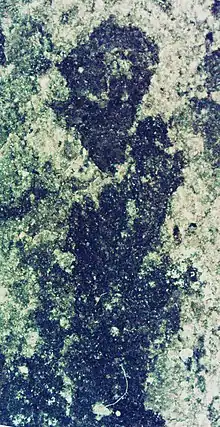Dollyphyton
Dollyphyton is a genus of fossil with controversial interpretation from the Middle Ordovician (Darriwilian, 460 million years old) Douglas Lake Member of the Lenoir Limestone from Douglas Dam Tennessee.[1] The generic name honors Dolly Parton whose Dollywood resort is nearby. The epithet honors Art Boucot.
| Dollyphyton Temporal range: | |
|---|---|
 | |
| Holotype of Dollyphyton boucotii, from the Douglas Lake Member of Lenoir Limestone, at Douglas Dam, Tennessee[1] | |
| Scientific classification | |
| Kingdom: | Plantae |
| Division: | Bryophyta |
| Class: | Sphagnopsida |
| Order: | Sphagnales |
| Family: | Flatbergiaceae |
| Genus: | †Dollyphyton Retallack (2019) [1] |
| Type species | |
| Dollyphyton boucotii Retallack (2019) | |
Description
Dollyphyton is considered as a fossil peat moss by Gregory Retallack. Its leaves are wide and have lateral teeth. Its capsule is terminal on a short pseudopodium.
Interpretation
Unlike most peat mosses Dollyphyton has broad leaves like those of the living peat moss Flatbergium, considered basal to Sphagnales.[2] Interpretation of this fossil as a peat moss has been doubted in some quarters[3] but accepted in others.[4]
References
- Retallack, G.J. (2019). "Ordovician land plants and fungi from Douglas Dam, Tennessee". The Palaeobotanist. 68: 1–33. doi:10.54991/jop.2019.43.
- Shaw, A.J.; Cox, C.J.; Buck, W.R.; Devos, N.; Buchanan, A.M.; Cave, L.; Seppelt, R.; Shaw, B.; Larrain, J.; Andrus, R.; Greilhuber, J. (2022). "Newly resolved relationships in an early plant lineage: Bryophyta Class Sphagnopsida (peat mosses)". American Journal of Botany. 974: 1511–1531.
- Edwards, Dianne; Morris, Jennifer L.; Axe, Lindsey; Duckett, Jeffrey G.; Pressel, Silvia; Kenrick, Paul (2022). "Piecing together the eophytes – a new group of ancient plants containing cryptospores". New Phytologist. 233 (3): 1440–1455. doi:10.1111/nph.17703. ISSN 0028-646X. PMID 34806774. S2CID 244495761.
- Leigh, Egbert (2022). "Fossil soils: trace fossils of ecosystems on land and windows on the context of evolution". Evolution Education and Outreach. 15 (14): 1–5. doi:10.1186/s12052-022-00173-3. S2CID 255483235.
This article is issued from Wikipedia. The text is licensed under Creative Commons - Attribution - Sharealike. Additional terms may apply for the media files.